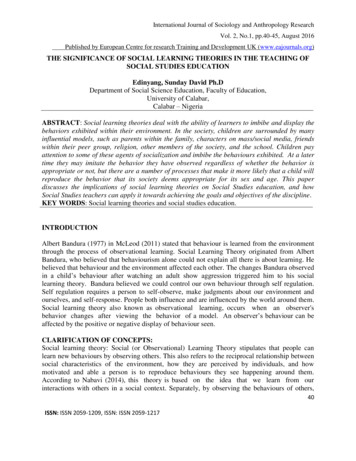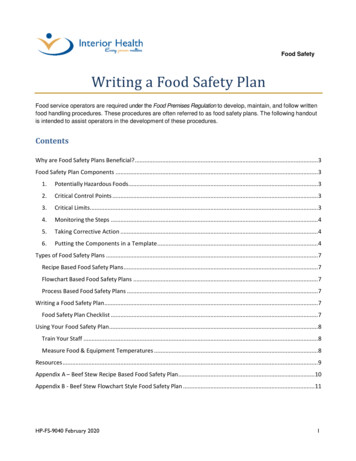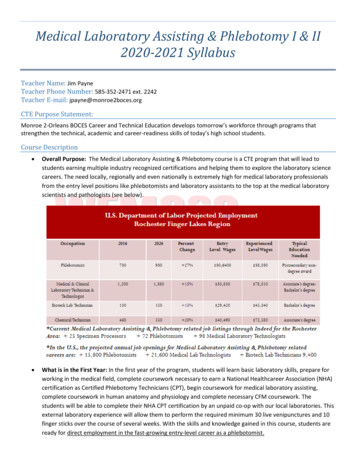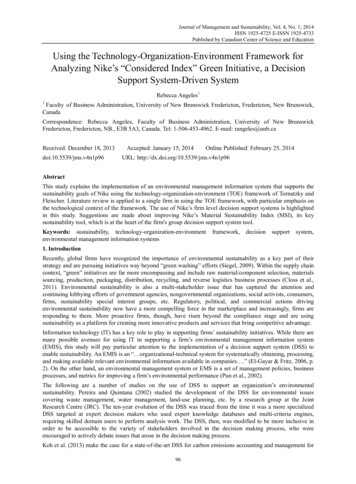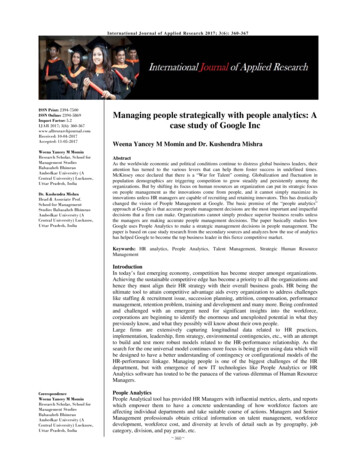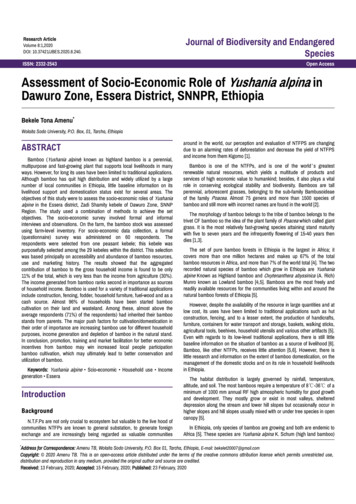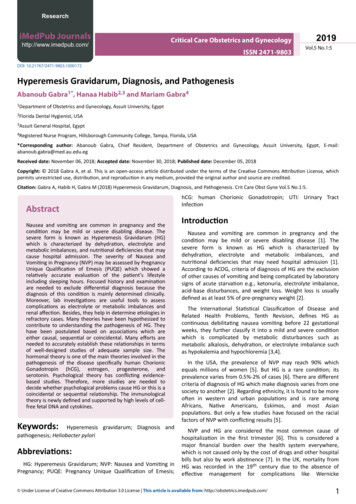
Transcription
ResearchiMedPub Journalshttp://www.imedpub.com/2019Critical Care Obstetrics and GynecologyISSN 2471-9803Vol.5 No.1:5DOI: 10.21767/2471-9803.1000172Hyperemesis Gravidarum, Diagnosis, and PathogenesisAbanoub Gabra1*, Hanaa Habib2,3 and Mariam Gabra41Department2Florida3Assuitof Obstetrics and Gynecology, Assuit University, EgyptDental Hygienist, USAGeneral Hospital, Egypt4RegisteredNurse Program, Hillsborough Community College, Tampa, Florida, USA*Corresponding author: Abanoub Gabra, Chief Resident, Department of Obstetrics and Gynecology, Assuit University, Egypt, E-mail:abanoub.gabra@med.au.edu.egReceived date: November 06, 2018; Accepted date: November 30, 2018; Published date: December 05, 2018Copyright: 2018 Gabra A, et al. This is an open-access article distributed under the terms of the Creative Commons Attribution License, whichpermits unrestricted use, distribution, and reproduction in any medium, provided the original author and source are credited.Citation: Gabra A, Habib H, Gabra M (2018) Hyperemesis Gravidarum, Diagnosis, and Pathogenesis. Crit Care Obst Gyne Vol.5 No.1:5.AbstractNausea and vomiting are common in pregnancy and thecondition may be mild or severe disabling disease. Thesevere form is known as Hyperemesis Gravidarum (HG)which is characterized by dehydration, electrolyte andmetabolic imbalances, and nutritional deficiencies that maycause hospital admission. The severity of Nausea andVomiting in Pregnancy (NVP) may be assessed by PregnancyUnique Qualification of Emesis (PUQE) which showed arelatively accurate evaluation of the patient’s lifestyleincluding sleeping hours. Focused history and examinationare needed to exclude differential diagnosis because thediagnosis of this condition is mainly determined clinically.Moreover, lab investigations are useful tools to assesscomplications as electrolyte or metabolic imbalances andrenal affection. Besides, they help in determine etiologies inrefractory cases. Many theories have been hypothesized tocontribute to understanding the pathogenesis of HG. Theyhave been postulated based on associations which areeither causal, sequential or coincidental. Many efforts areneeded to accurately establish these relationships in termsof well-designed studies of adequate sample size. Thehormonal theory is one of the main theories involved in thepathogenesis of the disease specifically human ChorionicGonadotropin (hCG), estrogen, progesterone, andserotonin. Psychological theory has conflicting evidencebased studies. Therefore, more studies are needed todecide whether psychological problems cause HG or this is acoincidental or sequential relationship. The immunologicaltheory is newly defined and supported by high levels of cellfree fetal DNA and cytokines.Keywords:Hyperemesis gravidarum; Diagnosis andpathogenesis; Heliobacter pyloriAbbreviations:HG: Hyperemesis Gravidarum; NVP: Nausea and Vomiting inPregnancy; PUQE: Pregnancy Unique Qualification of Emesis;hCG: human Chorionic Gonadotropin; UTI: Urinary TractInfectionIntroductionNausea and vomiting are common in pregnancy and thecondition may be mild or severe disabling disease [1]. Thesevere form is known as HG which is characterized bydehydration, electrolyte and metabolic imbalances, andnutritional deficiencies that may need hospital admission [1].According to ACOG, criteria of diagnosis of HG are the exclusionof other causes of vomiting and being complicated by laboratorysigns of acute starvation e.g., ketonuria, electrolyte imbalance,acid-base disturbances, and weight loss. Weight loss is usuallydefined as at least 5% of pre-pregnancy weight [2].The International Statistical Classification of Disease andRelated Health Problems, Tenth Revision, defines HG ascontinuous debilitating nausea vomiting before 22 gestationalweeks, they further classify it into a mild and severe conditionwhich is complicated by metabolic disturbances such asmetabolic alkalosis, dehydration, or electrolyte imbalance suchas hypokalemia and hypochloremia [3,4].In the USA, the prevalence of NVP may reach 90% whichequals millions of women [5]. But HG is a rare condition; itsprevalence varies from 0.5%-2% of cases [6]. There are differentcriteria of diagnosis of HG which make diagnosis varies from onesociety to another [2]. Regarding ethnicity, it is found to be moreoften in western and urban populations and is rare amongAfricans, Native Americans, Eskimos, and most Asianpopulations. But only a few studies have focused on the racialfactors of NVP with conflicting results [5].NVP and HG are considered the most common cause ofhospitalization in the first trimester [6]. This is considered amajor financial burden over the health system everywhere,which is not caused only by the cost of drugs and other hospitalbills but also by work abstinence [7]. In the UK, mortality fromHG was recorded in the 19th century due to the absence ofeffective management for complications like Wernicke Under License of Creative Commons Attribution 3.0 License This article is available from: http://obstetrics.imedpub.com/1
Critical Care Obstetrics and GynecologyISSN 2471-9803encephalopathy and aspiration pneumonia [4]. But withimproving treatment, the mortality rate has been dramaticallydecreased.DiagnosisAssessment of severityThe severity of NVP may be assessed by PUQE. The PUQEscore includes questions about the number of vomiting attacksper day, the length of nausea per day in hours and the numberof retching episodes, with a minimum score of 3 and a maximumscore of 15. A score of 6 suggests mild HG, 7-12 moderate HGand 13 or more indicates severe HG. The PUQE score may alsobe used to monitor treatment outcome during hospitaladmission day by day [8].Study of Lacasse, et al. compares 12 hours versus 24 hoursassessment by PUQE in order to have a more general idea aboutthe severity of condition including the sleeping hours [9]. The24-hour model was found to be correlated with 12-hour model,but it classified the cases more severely than the 12 hours one.Besides, it was found to be correlated with the deterioration ofthe quality of life assessed by the SF-12 model [9]. It was alsofound to be correlated to questionnaires for ability to intakemultivitamins daily and visiting the emergency unit for vomiting,higher the PUQE-24 was found to be associated with inability ofkeeping intake of daily vitamins and higher rate of visits toemergency unit due to vomiting, but sleep pattern was notaffected [10]. There are 2 confounding factors that affect thesleep pattern either nauseating pregnant women want to sleepmost of the day and night or it may be considered a side effectof antiemetics like antihistamines [10]. As a result of that, theauthors summarized that the 24-hour model is valid to assessthe severity of NVP in the first trimester [11].In 2016, RCOG provided physician guidelines for diagnosis andmanagement based on statistics of many studies. They validatethe diagnosis of HG based on the triad of more than 5% prepregnancy weight loss, dehydration, and electrolyte imbalance.NVP should only be diagnosed when onset is in the firsttrimester of pregnancy and other causes of nausea and vomitinghave been excluded. RCOG explained that onset of NVP is in thefirst trimester and if the initial onset is later, other causes needto be considered and excluded first. Its onset is between thefourth and seventh weeks of gestation, it peaks around the ninthweek and recovery occurs by the 20th week in 90% of patients.They confirmed that the PUQE score can be used to classify theseverity of NVP [12].HistoryIn patients with NVP, we should consider certain points duringhistory taking which include accurate dating of pregnancy andthe onset of symptoms during this pregnancy, past medicalhistory of NVP/HG, using PUQE score to assess severity,hypersalivation may occur in 60% of cases [5], spitting, loss ofweight, inability to keep food and fluids and assessing thedeterioration of quality of life. We should also exclude othercauses of vomiting which may include: abdominal pain, urinary22019Vol.5 No.1:5symptoms, infection, drug history, and chronic Helicobacterpylori infection [12]. It is unlikely for patients to have a fever,chills and rigors, headache and visual disturbance so if thesesymptoms present, other conditions should be considered [13].ExaminationThe examination should include temperature, pulse, bloodpressure, oxygen saturation, respiratory rate, abdominalexamination, signs of muscle wasting, dehydration and otherexamination as guided by history [12]. Dry lips and tongue,decreased skin turgor and reduced urine output are commonsigns of dehydration which should be excluded as they indicatethe need for hospital admission [13]. We should also try toexclude surgical causes like renal colic and appendicitis byexamination [13]. Molar pregnancy is suspected by high fundallevel not correlated with gestational age and it is confirmed byultrasound [13].InvestigationsInvestigations are needed to evaluate the disease anddetermine the severity, they should include urine dipstick forketones which should be monitored daily till becomes negativefor 2 successive days [13]. The mid-stream urine sample shouldbe taken as Urinary Tract Infection (UTI) may be considered as adifferential diagnosis. Urea level should be assessed as a severedisease may lead to pre-renal failure due to hypovolemia anddecreased renal perfusion, electrolytes panel should bemeasured to exclude hypokalemia, hyponatremia, metabolicalkalosis and other electrolyte imbalance [12]. Thoseinvestigations are very important tests as renal failure andelectrolyte imbalances are common [13]. Full blood countshould be done as infections like UTI causes leukocytosis,hematocrit value may be raised due to hemoconcentration [12].Pre-albumin levels may be low which indicate poor food intakeespecially protein and possible poor fetal weight gain [5].Random blood glucose may be needed to excludehypoglycemia as a complication of HG and to exclude diabeticketoacidosis as a differential diagnosis. An ultrasound scanshould be done to exclude molar pregnancy and multiplepregnancies as common obstetrics risk factors, besidesdetermining the viability of intrauterine pregnancy andconfirming gestational age [12].In refractory cases or history of previous admissions, RCOGrecommend checking thyroid function tests [12]. TSH levels maybe low in HG, due to the structural similarity between TSH andhCG and thyroid hormone levels should return to normalpostpartum [5]. The ACOG 2015 guidelines recommend thatserum thyroid function studies should be ordered only withsigns of hyperthyroidism [2].Liver function tests should be ordered to exclude liverdiseases such as hepatitis or gallstones [5]. Serum calcium,phosphate level, and serum amylase should be assessed toexclude pancreatitis. Arterial blood gases should be done toexclude metabolic disturbances such as metabolic alkalosis andalso to monitor the disease [12]. Upper GIT endoscopy can bedone safely in pregnancy and can be considered to rule outThis article is available from: http://obstetrics.imedpub.com/
Critical Care Obstetrics and GynecologyISSN 2471-9803gastritis or peptic ulcer disease; nausea and vomiting werefound to be the second most common indication for upper GITendoscopy in pregnancy after upper GIT hemorrhage [5].Besides, other investigations such as hemoglobin level, ABOgrouping, and Rhesus, VDRL and HIV serology test should be alsodone as part of routine antenatal care [13].Differential diagnosisOther diagnoses should be excluded as a part of criteria todiagnose NVP [6]. With the help of focused history, examinationand investigations, we can exclude other pathological causes ofnausea and vomiting include peptic ulcers, cholecystitis,gastroenteritis, hepatitis, pancreatitis, genitourinary conditionssuch as urinary tract infection or pyelonephritis, metabolicconditions, neurological conditions, and drug-induced nauseaand vomiting [12].The presentation of severe abdominal pain is unexpected tooccur with NVP and HG which indicate a further investigation ofserum amylase levels and an abdominal sonography oresophageal gastroduodenoscopy [12]. Chronic infection with H.pylori can co-exist and serodiagnosis may be needed [14].Etiology and TheoriesMany etiologies have been theorized to be related to NVP andHG, so we need well-controlled studies of adequate sample sizein order to establish the causal relationship between them andthe disease [1].Hormonal theoryhuman Chorionic Gonadotropin (hCG): It has been theorizedthat NVP is related to high hCG production by placenta, as it wasdiscovered in the 1940s by Schoeneck who found that thosepatients have high level of urinary hCG [1] This association issupported by higher incidence of disease in multiplepregnancies, molar pregnancy, and pregnancy with a fetusaffected by Down syndrome [15]. We should be careful indetermining the causal relationship because actually, the exactrole of hCG is still unclear and in addition to that otherconditions with a high level of hCG like choriocarcinoma do notpresent as vomiting, also some pregnant women with highserum level of hCG do not complain of vomiting [15]. That is whyresearchers started working on the sensitivity of TSH receptorsto hCG and they found that at certain patients, there is amutation in the extracellular domain of the receptors makingthem responsive to even normal hCG serum levels [16].Interestingly it is well known that there is a structural similaritybetween hCG and TSH [17]. Laboratory bias during measuringhCG is found due to different assays used to detect differentserotypes of hCG [15].Estrogen: High serum level of estrogen in patients with HGpoints to the role of estrogen hormone in the pathogenesis ofthe disease [15]. Moreover, nausea and vomiting are well-knownside effects of estrogen-containing birth controls [15]. Estrogendecrease intestinal motility and gastric emptying, also it causesfluid shift favors to decrease the acidity of the stomach and Under License of Creative Commons Attribution 3.0 License2019Vol.5 No.1:5potentiate the growth H. pylori [15]. Smoking pregnant womenhave a lower level of estrogen hormone and they are lesscommon to have NVP [18,19].On the other hand, estrogen level increases with pregnancybut NVP commonly alleviate after the first trimester that is whythis causal relation needs to be well studied to allow us figuringout if there are confounding factors or estrogen has an effectmodification in presence of other risk factors [5].Progesterone: Researchers keep in mind the high function ofcorpus luteum in the first trimester with high progesterone level[20] so that they postulate an association between highprogesterone level and NVP [15]. The fact may be attributed tothe effect of progesterone on sphincters like the relaxation oflower esophageal sphincter [17]. Level of progesterone goeshigher with pregnancy so this association needs further studieslike estrogen. Besides, no sufficient data support the correlationbetween severity of the disease and high level of progesterone[3].Serotonin: Serotonin has its own role in the pathogenesis ofvomiting through its effect on CNS and GIT [15]. AlthoughBorgeat, et al. found that pregnant women with HG do not havehigh serum levels of serotonin. The role of anti-serotonin drugsin chemotherapy-induced vomiting and their effectiveness in HGare 2 strong evidence-based facts leading to support thisassociation [17].Psychological theoryThe association between HG and psychological disorders hasbeen already supported by many studies [4] and some studiespoint to underestimation of this obvious relationship [2]. But thecausal relationship between those disorders and HG has notbeen proved yet [1,19] because studies reported thepsychological burden as a consequence of NVP and HG [21].Moreover, the coincidence of both psychological disease and HGprolongs the duration of HG [22]. Besides that, a correlation wasfound between the severity of vomiting and a degree ofpsychological dysfunction in terms of anxiety, sleep disorder andmood disorder [4].Immunological theory:Cell-free fetal DNA: Studies found that HG patients have ahigh serum level of fetal cell-free DNA which was also found tobe high in patients with preterm labor, preeclampsia and Down’ssyndrome [23]. Immunological interaction between mother andfetus is a well-balanced condition and essential for the integrityof pregnancy because it regulates invasion of trophoblasts toendometrium [24]. If maternal immunity weakens, trophoblastswould invade the uterus aggressively [25]. This brakingmechanism is mediated by the activity of cytotoxic T cells andnatural killer cells which was found to be abundant inhistopathological examination of the endometrium of patientswith HG [23]. Therefore, it has been postulated that abnormalimmunological reactions, mediated by cytotoxic T cell andnatural killer cells, occur towards trophoblasts of the fetus whichcauses high serum level of cell-free fetal DNA due to cell inducedcytotoxicity [25]. Moreover, correlations were found between3
Critical Care Obstetrics and GynecologyISSN 2471-9803serum levels of cell-free fetal DNA and both severity of vomitingand hCG level [23].Cytokines: High serum level of cytokines was found in HGpatients especially TNF-alpha which is linked to the secondarymessenger process after hormone-receptor interaction [26].This may be explained by immunological imbalance favoringhumoral immunity which is considered one of the physiologicalchanges in pregnancy exacerbated in HG [15]. This overactivehumoral immune response increases the level of IL-4 and TNFalpha besides adenosine in order to attenuate this effect [15].This immune theory is supported by the effectiveness of steroidsin some refractory cases [27].SummaryNausea and vomiting are common in pregnancy and thecondition may be mild or severe disabling disease. The severeform is known as HG which is characterized by dehydration,electrolyte and metabolic imbalances, and nutritionaldeficiencies that may cause hospital admission. The severity ofNVP may be assessed by PUQE. Focused history andexamination are needed to exclude the differential diagnosis.Moreover, lab investigations are useful tools to assesscomplications. Many theories have been hypothesized tocontribute to the pathogenesis of HG. Hormones like estrogen,progesterone, hCG, and serotonin may play a role. Cytokines andfetal cell-free DNA are considered evidence for immunologicaletiology. A debate is found between researchers regardingpsychological etiology because a causal relationship has notbeen established yet.References1.Philip B (2003) Hyperemesis gravidarum: literature review. WMJ102: 46-51.2.London V, Grube S, Sherer DM, Abulafia O (2017) Hyperemesisgravidarum: A review of recent literature. Pharmacology 100:161-171.3.Lagiou P, Tamimi R, Mucci LA, Trichopoulos D, Adami HO, et al.(2003) Nausea and vomiting in pregnancy in relation to prolactin,estrogens, and progesterone: a prospective study. Obstet Gynecol101: 639-644.4.Ismail SK, Kenny L (2007) Review on hyperemesis gravidarum. BestPract Res Clin Gastroenterol 21: 755-769.5.Lee NM, Saha S (2011) Nausea and vomiting of pregnancy.Gastroenterol Clin North Am 40: 309-334.6.Castillo MJ, Phillippi JC (2015) Hyperemesis gravidarum: a holisticoverview and approach to clinical assessment and management. JPerinat Neonatal Nurs 29: 12-22.7.McCarthy FP, Lutomski JE, Greene RA (2014) Hyperemesisgravidarum: Current perspectives. Int J Womens Health 6:719-725.8.Chhetry M, Thakur A, Uprety DK, Basnet P, Joshi R (2016)Hyperemesis gravidarum in a tertiary care centre in eastern Nepal:A prospective observational study. J Ayub Med Coll Abbottabad28: 18-21.9.2019Vol.5 No.1:5Lacasse A, Bérard A (2008) Validation of the nausea and vomitingof pregnancy specific health related quality of life questionnaire.Health Qual Life Outcomes 6: 1-6.10. Ebrahimi N, Maltepe C, Bournissen FG, Koren G (2009) Nausea andvomiting of pregnancy: Using the 24-hour Pregnancy-UniqueQuantification of Emesis (PUQE-24) scale. J Obstet Gynaecol Can31: 803-807.11. Dochez V, Dimet J, David-Gruselle A, Le Thuaut A, Ducarme G(2016) Validation of specific questionnaires to assess nausea andvomiting of pregnancy in a French population. Int J Gynecol Obstet134: 294-298.12. Maltepe C, Koren G (2016) The management of nausea andvomiting of pregnancy and hyperemesis gravidarum-a 2013update. J Popul Ther Clin Pharmacol 20: 184-192.13. Loh KY, Sivalingam MFN (2005) Understanding hyperemesisgravidarum. Med J Malaysia 60: 394-399.14. Golberg D, Szilagyi A, Graves L (2007) Hypermesis grvidarum andH. pylori infection: a systematic review. Obstet Gynecol 110:695-703.15. Verberg MF, Gillott DJ, Al-Fardan N, Grudzinskas JG (2005)Hyperemesis gravidarum, a literature review. Hum Reprod Update11: 527-539.16. Rodien P, Jordan N, Lefevre A, Royer J, Vasseur C, et al. (2004)Abnormal stimulation of the thyrotrophin receptor duringgestation. Hum Reprod Update 10: 95-105.17. Eliakim R, Abulafia O, Sherer DM (2000) Hyperemesis gravidarum:a current review. Am J Perinatol 17: 207-218.18. Depue RH, Bernstein L, Ross RK, Judd HL, Henderson BE (1987)Hyperemesis gravidarum in relation to estradiol levels, pregnancyoutcome, and other maternal factors: a seroepidemiologic study.Am J Obstet Gynecol 156: 1137-1141.19. Fell DB, Dodds L, Joseph KS, Allen VM, Butler B (2006) Risk factorsfor hyperemesis gravidarum requiring hospital admission duringpregnancy. Obstet Gynecol 107: 277-284.20. Yoneyama Y, Suzuki S, Sawa R, Yoneyama K, Doi D, et al. (2002) TheT-helper 1/T-helper 2 balance in peripheral blood of women withhyperemesis gravidarum. Am J Obstet Gynecol 187: 1631-1635.21. McCarthy FP, Khashan AS, North RA, Moss-Morris R, Baker PN, etal. (2011) A prospective cohort study investigating associationsbetween hyperemesis gravidarum and cognitive, behavioural andemotional well-being in pregnancy. PLoS One 6: 1-7.22. Kjeldgaard HK, Eberhard-Gran M, Benth JS, Vikanes AV (2017)Hyperemesis gravidarum and the risk of emotional distress duringand after pregnancy. Arch Women’s Ment Health 20: 747-756.23. Sugito Y, Sekizawa A, Farina A, Yukimoto Y, Saito H, et al. (2003)Relationship between severity of hyperemesis gravidarum andfetal DNA concentration in maternal plasma. Clin Chem 49:1667-1669.24. Mullin PM, Bray A, Vu V, Schoenberg-Paik F, MacGibbon K, et al.(2012) No increased risk of psychological/behavioral disorders insiblings of women with hyperemesis gravidarum (HG) unless theirmother had HG. J Dev Orig Health Dis 3: 375-379.25. Sekizawa A, Sugito Y, Iwasaki M, Watanabe A, Jimbo M, et al.(2001) Cell-free fetal DNA is increased in plasma of women withhyperemesis gravidarum. Clin Chem 47: 2164-2165.26. Kaplan PB, Gücer F, Sayin NC, Yüksel M, Yüce MA, et al. (2003)Maternal serum cytokine levels in women with hyperemesis4This article is available from: http://obstetrics.imedpub.com/
Critical Care Obstetrics and GynecologyISSN 2471-9803gravidarum in the first trimester of pregnancy. Fertil Steril 79:498-502. Under License of Creative Commons Attribution 3.0 License2019Vol.5 No.1:527. Jarvis S, Nelson-Piercy C (2011) Management of nausea andvomiting in pregnancy. BMJ 342: 1-8.5
Hyperemesis Gravidarum, Diagnosis, and Pathogenesis Abanoub Gabra1*, Hanaa Habib2,3 and Mariam Gabra4 1Department of Obstetrics and Gynecology, Assuit University, Egypt 2Florida Dental Hygienist, USA 3Assuit General Hospital, Egypt 4Registered Nurse Program, Hillsborough Community College, Tampa, F
